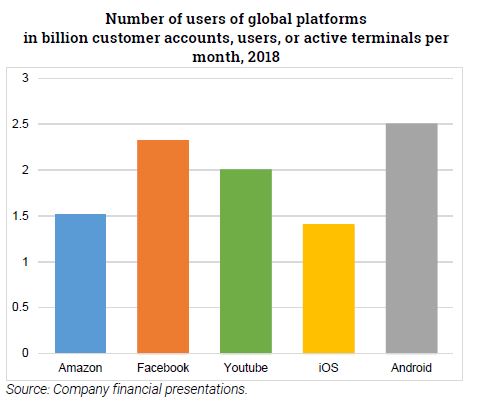Trésor-Economics No. 250 - Digital platforms and competition
The dominant position of certain major digital platforms, and their role as intermediaries in certain markets, raises increasing concerns about their ability to restrict competition in and for these markets. Faced with these issues, a strengthening of competition policy and the introduction of specific regulatory tools appear desirable.
The digital platforms that make it possible for different users to interact have taken an increasingly important role in many sectors. Indeed, network effects and the possibilities opened up by digital technologies have enabled the most effective platforms to grow rapidly on a large scale, acquire dominant positions, and benefit from comparative advantages to diversify.
Despite the benefits generated by the digital economy and platform development, the trend towards market concentration and weakening competition raises growing economic concerns. The ability for competition law to fully grasp the digital economy and to effectively combat potential abusive practices undertaken by platforms is an increasingly debated topic around the world.
Several studies have highlighted the intensifying challenges to competition raised by platform models and to instances of strong positions. By controlling access to the market and through their role in structuring information, platforms can deploy unfair or anti-competitive practices that restrict competition in the market. Dominant platforms can also deploy barriers to competition for the market, by blocking the entrance of competitors through "lock-in" strategies or more predatory practices.
To address these issues, it seems necessary, on the one hand, to revise the competition policy in order to adopt the tools and rules needed to become more responsive and effective when dealing with the specificities of platform models, and, on the other, to enhance the resources available to competition authorities for analysing these markets.
As a complement, public authorities can protect and encourage competition and innovation on platform markets by using various tools that enhance prevention and ex-ante regulation of practices. On the one hand, general ("symmetric") and sectoral rules and obligations can address particularly recurring competition problems, lay out binding principles, and reduce certain barriers to entry. On the other hand, when markets or stakeholders pose competition problems that are structural and persistent, "asymmetric" regulations should allow to establish targeted and proportionate rules and obligations to restore more competitive conditions. Such a framework could be considered at the European Union level.
